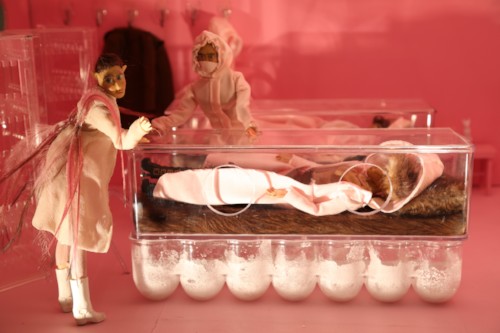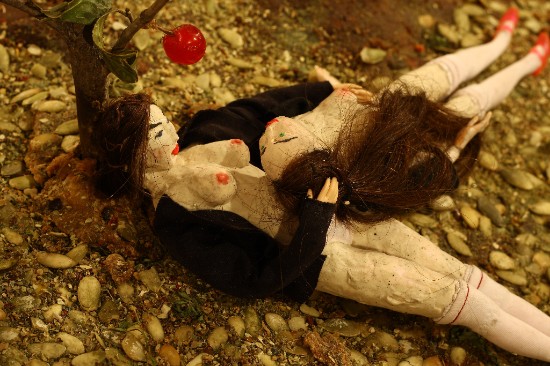Rebecca Agnew is a New Zealand born painter, sculptor and Stop Animator based in Melbourne. She started her two-year tenure as a Gertrude Studio Artist in the second half of 2017.
Rebecca has taken part in a number of international exhibitions and animation festivals, including Melbourne International Animation Festival, (Internationally touring), M100, Santiago, Chile and Interior 2.1 (TRAMA Centro), Guadalajara, Mexico. She has undertaken a number international residencies, including Waaw, Saint Louis, Senegal and Theertha Red Dot Gallery, Colombo, Sri Lanka. In 2014, she was awarded the Artstart Grant and 2015, the Keith and Elisabeth Murdoch Travelling Fellowship. In 2013 Rebecca was commissioned by Artbank to produce a Stop Animation Swan Song, which is now part of the permanent collection.
Rebecca recently conducted a series of workshops as part of Gertrude Contemporary's MEET MAKE CREATE at the NGV Triennial. Gertrude Gallery Coordinator, Siobhan Sloper, spoke to Rebecca about her practice and her time at Gertrude so far.
Siobhan Sloper: Your practice traverses painting, sculpture and stop motion animation. Stop motion animation isn’t a medium we see used a lot in contemporary art, how did you first become involved with it?
Rebecca Agnew: I fell in love with stop-motion animation in 2007 and have made many short films since that time. The medium may be time and labour intensive, but the rewards come through the freedom you have to act out every aspect of your narrative, like a frustrated bedroom actress. The first stop motion animation I did was a collaboration for a band, The Bonscotts. I received an Australian Council VIC Rocks grants to produce the three music videos. I continued making stop-motion animation as part of my masters program at VCA because it transformed my sculpture from being static objects to miniature outer worldly narratives.
SS: Your animation’s Swan Song, Europa, Eve and Eve and Lovely Bonescentre upon female characters thrust into difficult moral or ethical situations. What is it about puppets that you feel make them an appropriate medium to explore these issues?
RA: Interesting question, I started looking at photographic images of uniformed groups of homogeneous women. I was obsessed by the micro expressions and subtext that emerged from analysing each individual. Puppets to me are a powerful tool to act out moral quagmires because gesture and facial expression is the main language of animation. I wanted to explore sex and gender, creating a kind of Amazonian race as a disruptive way to imbue some humour and exaggerate corners of the human condition unravelling roles of desire, conflict and oppressions. In stop-motion animation you can build uncanny worlds which allow reality to become suspended, so the ethical conundrums are contained to a space where the ambiguous non-reality is hopefully where the audience find a little sense of the miraculous.
SS: Your narratives remind me of the earliest fairy tales (Grimm and pre -"happily ever after") - What was your favourite fairytale as a child?
RA: Yes, I enjoy their works! The Grimm Brothers early folklore works have a lot of unsanitised violence and cruelty reflecting on the culture and politics of the time, while still placing you into a moral tale. I am also attracted to 19th Century fiction writers using moral dilemma in a way that often does not end in the happily ever after, but by using exaggerated scenarios you are forced to examine human behaviour.
My favourite story was Bony Legs by Joanna Cole, a small girl is trying to escape a witch in a house that stood on chicken legs - the whole world becomes animated and sentient in her quest to escape.
SS: You also appropriate to a number of religions and ancient cultures in your works, what is your intention in referencing these?
I am often drawn to, and inspired by incorporating discordant art, ideas and themes- building up a kind of textured mythology. In my storytelling I use moral tales and ideologies as a trope, connecting history to current global culture. In a way I want to add layers of visual details, ideas and universal themes so the message becomes a convoluted climatic moment, and then....
SS: and then... the audience is left to resolve the dilemma themselves, informed by their own personal, social or global context?
RA: Exactly, now I am looking at the ideas around Dataism and values around mobile phones.
SS: Could you expand a little on this new project?
RA: Its exciting to be researching new themes. I’m making five stop motion animation sets with each narrative thread reflecting on life with mobile phones in our cultural and global economy. The sets track the phone from its mining of resources to how we behave in relation to big data ideas; patterns and associations that shape our behaviour and interaction. I just read an interesting article on Silicon Valley preparing for dooms day by building apocalyptic havens in New Zealand, while I will not be so monolithic I will definitely be looking at some of the dark sides of mobile phones!
SS: You have been in your Gertrude studio for 6 months now. How have you found the Gertrude Studio Program experience?
RA: It has been a pleasure to be part of the studio program so far. It has allowed me to have more space and the ability to plan longer and more ambiguous works. Coming from having a studio at home I am now able to open my studio and have support from a wider community of artists and professionals.



